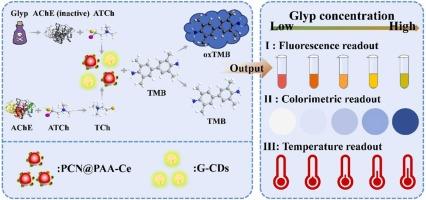基于铈包覆金属-有机框架的多模态草甘膦“三合一”检测平台
IF 11.3
1区 环境科学与生态学
Q1 ENGINEERING, ENVIRONMENTAL
引用次数: 0
摘要
草甘膦(Glyp)是一种广泛使用的除草剂,但由于长期过量喷洒,其残留会对人体健康造成重大危害。利用铈/聚丙烯酸修饰卟啉基金属有机骨架(PCN@PAA-Ce),开发了一种结合荧光、比色和光热检测的比例多模态传感平台,用于Glyp检测。检测策略依赖于Glyp对乙酰胆碱酯酶的抑制作用、PCN@PAA-Ce氧化酶样活性以及酶产物与3,3 ',5,5 ' -四甲基联苯胺(TMB)之间的竞争。甘氨酸抑制乙酰胆碱酯酶,阻止乙酰硫胆碱的水解和还原性硫胆碱的产生。PCN@PAA-Ce的类氧化酶性质使TMB(无色)氧化为氧化后的TMB (oxTMB)(蓝绿色),而荧光共振能量转移使oxTMB猝灭PCN@PAA-Ce的红色荧光。在紫外光下,探针溶液显示黄绿色荧光作为参考信号。此外,oxTMB出色的光热转换使探针能够通过光热响应响应Glyp。三种模式的检测范围分别为1×10-5 ~ 4 mg mL-1、1×10-4 ~ 6 mg mL-1和1×10-4 ~ 6 mg mL-1,检出限分别为9.85 × 10-6 mg mL-1、8.69 ×10-5 mg mL-1和9.72 ×10-5 mg mL-1。与单模探头相比,多模探头的自验证功能提供了更准确和稳定的检测,具有更广阔的应用潜力。本文章由计算机程序翻译,如有差异,请以英文原文为准。

A “three-in-one” detection platform based on cerium-coated metal-organic framework for multimodal glyphosate detection
Glyphosate (Glyp) is a widely used herbicide, but its through prolonged and excessive spraying residues pose significant health risks. A ratiometric multimodal sensing platform combining fluorescence, colorimetry, and photothermal detection was developed for Glyp detection using a cerium/polyacrylic acid-modified porphyrin-based metal-organic framework (PCN@PAA-Ce). The detection strategy relies on the inhibition of acetylcholinesterase by Glyp, the oxidase-like activity of PCN@PAA-Ce, and the competition between enzymatic products and 3,3′,5,5′-tetramethylbenzidine (TMB). Glyp inhibits acetylcholinesterase, which prevents the hydrolysis of acetylthiocholine and the production of reduced thiocholine. The oxidase-like property of PCN@PAA-Ce facilitates the oxidation of TMB (colorless) to oxidized TMB (oxTMB) (blue-green), while fluorescence resonance energy transfer caused oxTMB to quench the red fluorescence of PCN@PAA-Ce. Under ultraviolet light, the probe solution exhibits yellow-green fluorescence as a reference signal. Additionally, the excellent photothermal conversion of oxTMB enables the probe to respond to Glyp through photothermal responses. The detection ranges in the three modes were 1×10-5 to 4 mg mL-1, 1×10-4 to 6 mg mL-1, and 1 × 10-4 to 6 mg mL-1, respectively, with detection limits of 9.85 × 10-6 mg mL-1, 8.69 × 10-5 mg mL-1, and 9.72 × 10-5 mg mL-1, respectively. Compared to a single-mode probe, the multimodal probe’s self-verification function provides more accurate and stable detection, offering broader potential for application.
求助全文
通过发布文献求助,成功后即可免费获取论文全文。
去求助
来源期刊

Journal of Hazardous Materials
工程技术-工程:环境
CiteScore
25.40
自引率
5.90%
发文量
3059
审稿时长
58 days
期刊介绍:
The Journal of Hazardous Materials serves as a global platform for promoting cutting-edge research in the field of Environmental Science and Engineering. Our publication features a wide range of articles, including full-length research papers, review articles, and perspectives, with the aim of enhancing our understanding of the dangers and risks associated with various materials concerning public health and the environment. It is important to note that the term "environmental contaminants" refers specifically to substances that pose hazardous effects through contamination, while excluding those that do not have such impacts on the environment or human health. Moreover, we emphasize the distinction between wastes and hazardous materials in order to provide further clarity on the scope of the journal. We have a keen interest in exploring specific compounds and microbial agents that have adverse effects on the environment.
 求助内容:
求助内容: 应助结果提醒方式:
应助结果提醒方式:


